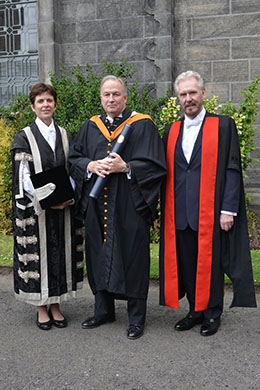Laureation address – Professor Christopher Brown CBE
Professor Christopher Brown CBE
Honorary Degree of Doctor of Letters
Laureation by Professor Brendan Cassidy
School of Art History

Receiving the first honorary degree this week was Professor Christopher Brown, museum curator and expert in Dutch and Flemish art (centre) who was awarded an Hon DLitt. To his left is the Principal Professor Louise Richardson and on his right is Laureator Professor Brendan Cassidy.
Vice-Chancellor, it is my privilege to present Professor Christopher Paul Hadley Brown for the Degree of Doctor of Letters, honoris causa.
Christopher Brown is not only one of the most distinguished and successful museum directors of his generation but also the pre-eminent British authority on Dutch and Flemish art of the seventeenth century, that Golden Age which had as its towering figures, Rembrandt and Vermeer, Rubens and Van Dyck.
Trained as a historian at Oxford and with a doctorate from the Courtauld Institute, he began his career at the National Gallery in London where he remained for 27 years. It was there that he acquired the manifold skills required of the modern museum professional; not least the ability to raise money and to communicate the importance and value of art to a diverse public and to the politicians who hold the purse strings. Most crucially, he played a key role in planning the extension to the National Gallery, the magnificent Sainsbury Wing off Trafalgar Square.
Whenever his administrative burdens permitted he turned his attention to researching the gallery’s collections and organising numerous exhibitions. He produced eight books, some twenty catalogues and countless articles, which opened up the field of Dutch and Flemish painting to scholars and the public. His first book on Bruegel was written when he was in his 20s. This was followed by a two-volume catalogue of the paintings of Rembrandt and a much-admired book on Van Dyck. In crisply elegant prose he conveyed Van Dyck’s extraordinary talents as an image maker, in both senses of the term; not only as a supremely gifted painter but one who also applied his talents to the business of image management. It was Van Dyck who, through his lavishly exuberant paintings, provided the physically-challenged and uncharismatic Charles I with a public image that enhanced the king’s majesty and authority. In another innovative and extremely readable book Professor Brown investigated the Dutch taste for scenes of everyday life. These apparently straightforward and sometimes witty paintings, as he explained, were often veiled comments on contemporary society; they served as warnings against certain forms of behaviour or promoted values that the Dutch esteemed; hard work, for example, or abstinence or the virtues of family life. Like all of Christopher Brown’s publications, it is a book in which meticulous research is accompanied by close readings of the paintings in an attempt to understand how they might have been understood at the time they were made.
Although his achievements as a scholar are significant it is as a museum director that he has probably made the greater impression on British culture. He has taken the oldest public museum in Britain; the Ashmolean in Oxford founded in 1683, and transformed it into one of the most dynamic and most beautiful art museums to be found anywhere. Some of you may remember the old Ashmolean: a dark and forbidding place in which one sometimes felt like an unwelcome guest at a rather exclusive if sombre party. Now the place is abuzz. More of the extraordinary collections are on display and they have room to breathe. The building is filled with light. Walkways and bridges in a six-storey atrium afford tantalising glimpses of galleries and objects that are beautifully displayed and intelligently labelled. Everything, it would seem has been calculated to optimise the visitor’s intellectual and aesthetic enjoyment (or experience, as it is now called). The new architecture is both elegant and timeless and sits comfortably and respectfully alongside the Victorian building of which it is a part. On a recent visit I heard a group of excited schoolchildren declare that the place was ‘cool’ – surely the highest accolade. As an art historian of a certain age, I found it ‘super cool’; it is a museum that takes seriously its obligations to educate and inspire, to delight and entertain. It is a monument to clear-sighted intelligence and ambition and to a vision of what a great museum should be; and much of the credit for this must go to its Director, Christopher Brown.
Therefore, Vice-Chancellor, for his outstanding contribution to British cultural life and to scholarship, I invite you to confer on Professor Christopher Brown the Degree of Doctor of Letters, honoris causa.
Category Awards